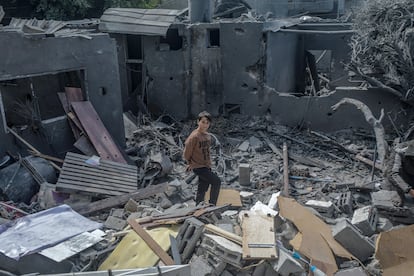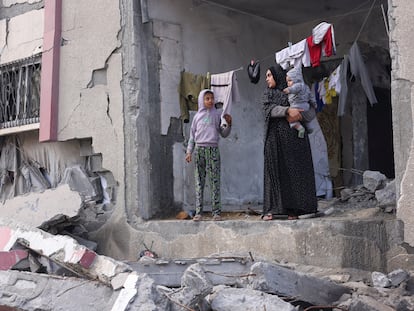Why Israel-Hamas ceasefire talks have stalled: Disputes over prisoner swap and the end of Gaza war
Negotiations for a second pause in hostilities have run aground a few days before the start of the holy month of Ramadan. The Islamist group wants guarantees that it will be indefinite, while Israel is concerned about how many of the hostages are dead

A few days before the start of the holy month of Ramadan, negotiations for a second Israel-Hamas ceasefire have stalled just as the word “optimism” was being repeated most frequently. The talks — which will resume on Sunday — have run aground due to mistrust. Israel is demanding a list of how many of the 134 hostages are alive and how many are not. While Hamas wants guarantees that the temporary ceasefire will become definitive — a condition rejected by Israel — and fears agreeing to a phased deal that will fall apart once the hostages are freed.
For weeks, there have been high expectation about the possibility of a second ceasefire — following the first in the last week of November — to swap Israeli hostages for Palestinian prisoners. U.S. President Joe Biden even said an agreement was going to be reached by last Monday. But in the end, the Israeli delegation did not even fly to Cairo for the talks, and the Hamas delegation ended up withdrawing on Thursday after making no progress after four days of negotiations with the mediators: the United States, Qatar and Egypt.
The basic points of the first phase are clear: a six-week ceasefire to exchange 40 (of the more than 130) Israeli hostages in Gaza for 400 Palestinian prisoners and an increase in humanitarian aid to Gaza, which is on the brink of famine. According to Biden, Israel accepted these terms and the ball was in Hamas’s court. But in a statement to Reuters, a senior official of the Islamist movement, Sami Abu Zuhri, has blamed Israel for “thwarting” the negotiating efforts by refusing to stop the aggression, withdraw its forces and ensure the free entry of aid and the return of displaced Gazans.
The problem lies in the details and the horizon for the war in Gaza. These are the main differences that are holding back the ceasefire agreement:
Temporary ceasefire or end of war
Both Israel and Hamas understand that an eventual ceasefire agreement would not mark a definitive end to the hostilities. But they differ on whether it will be a step in that direction: Hamas wants it to be, but Israel does not. As Hamas leaders left Cairo on Thursday, they complained that the negotiations were only focused on the first phase: the release of 40 hostages, made up of women, men under 19 and over 50, and the sick.
Hamas would like to immediately move to a second phase afterward, but only once both sides agree, through the mediators, on “the necessary requirements” to definitively end the war. In this second phase, it would hand over the rest of the hostages who are alive and dozens of corpses in exchange for the Israeli army’s complete withdrawal from Gaza. Israel rejects this proposal, as it fears that international pressure will prevent it from reinvading Gaza. It would mean that Israel would have failed to meet its objectives, by leaving a sort of Hamas government active.
“Hamas will be looking for maximum guarantees in exchange for the release [of the hostages], because when it releases them it will have run out of ways to pressure Israel,” says Mabel González Bustelo, an expert in international mediation and conflict resolution at the Institute of Studies on Conflict and Humanitarian Action (IECAH). “Ceasefire negotiations are very difficult, almost as difficult as those at the end of a war,” she adds.
Distrust is prevailing over the talks. A Hamas leadership source quoted by the Al-Mayadeen TV channel blamed the stalled talks on Israel, arguing it “will not provide clear answers” to its demands. Israel meanwhile does not believe Hamas official Basem Naim’s claim that the group does not know how many hostages are alive (not all of them are in their hands) nor can determine the number without a ceasefire.

Avi Issacharoff, a military affairs commentator in the Israeli newspaper Yediot Aharonot, believes that Hamas leader Yahya Sinwar is “betting everything” that, if Israel does not accept an end to the war (which Hamas would present as a victory), the month of Ramadan would “mark a change,” sparking a major uprising backed by Palestinians from the West Bank or with Israeli citizenship.
“With a few days to go before Ramadan, multiple measures are being used to pressure the other side and try to force them to change. But, at the same time, when they leave the table, the negotiation continues. You don’t just negotiate at the table,” says González Bustelo.
During the month of Ramadan, which will begin on Sunday evening, with the first day of fasting on Monday, any incident can trigger unrest on the street.
On Thursday, Israel’s Interior Minister Moshe Arbel and the head of the internal security services (Shin Bet), Ronen Bar, met with officials from the Israeli Arab community. The minister acknowledged that they have a “challenge” ahead of them.
Return of Gazans displaced from the north
Hamas has focused its demands on five points: the exchange of hostages for prisoners, the ceasefire, the withdrawal of Israeli troops and the end of its siege, the unlimited entry of humanitarian aid and the return of displaced Gazans to their homes, Hamas official Mahmud Mardawi told the Palestinian agency Quds News. The last point has turned into a major stumbling block. Hamas is demanding that some of the hundreds of thousands of Gazans from the north, who the Israeli army displaced to the south, be allowed to return to see the state of their homes. Most are damaged or destroyed.
The Israeli army fears that this will lead to the reorganization of Hamas battalions in the north, an area which — in its own jargon — it has “cleansed.” In fact, few things cause more shock in Israel than the ― very infrequent ― rocket fire from areas from which Israeli troops have withdrawn or the video that showed the hostages leaving underground (for the first exchange) in an area that had been cleared by the Israeli army. Hamas wants 500 families to be able to return on each day of the ceasefire, according to the Saudi TV network Al Arabiya. Israel is open to the idea, but only wants women and children to return. It is still under consideration whether elderly men, who are too old to fight, may be included in this plan.
Prisoners with “blood on their hands”
According to sources familiar with the ceasefire talks, cited by the Israeli newspaper Haaretz, in the first phase, Hamas is asking for the release of 100 prisoners “with blood on their hands,” as those who have killed Israelis for nationalist motives are called in the country. Israeli Prime Minister Benjamin Netanyahu has been ambiguous on this point, stating only that he will not release “hundreds of terrorists” in exchange for the hostages.
Another tricky issue is who will be released. Hamas is calling for the release of the most famous prisoner: Marwan Barghouti, who was sentenced to five life sentences and has been behind bars since 2002. Aware of its weakness on the battlefield, the Islamic Resistance Movement (the full name of Hamas) wants to take advantage of the more than 240 Israeli hostages it captured on October 7 — the largest number in Israel’s history. Hamas knows that, once they are handed over, it will have lost its main weapon to demand an end to the war.
Sign up for our weekly newsletter to get more English-language news coverage from EL PAÍS USA Edition
Tu suscripción se está usando en otro dispositivo
¿Quieres añadir otro usuario a tu suscripción?
Si continúas leyendo en este dispositivo, no se podrá leer en el otro.
FlechaTu suscripción se está usando en otro dispositivo y solo puedes acceder a EL PAÍS desde un dispositivo a la vez.
Si quieres compartir tu cuenta, cambia tu suscripción a la modalidad Premium, así podrás añadir otro usuario. Cada uno accederá con su propia cuenta de email, lo que os permitirá personalizar vuestra experiencia en EL PAÍS.
¿Tienes una suscripción de empresa? Accede aquí para contratar más cuentas.
En el caso de no saber quién está usando tu cuenta, te recomendamos cambiar tu contraseña aquí.
Si decides continuar compartiendo tu cuenta, este mensaje se mostrará en tu dispositivo y en el de la otra persona que está usando tu cuenta de forma indefinida, afectando a tu experiencia de lectura. Puedes consultar aquí los términos y condiciones de la suscripción digital.
More information
Archived In
Últimas noticias
Most viewed
- Sinaloa Cartel war is taking its toll on Los Chapitos
- Oona Chaplin: ‘I told James Cameron that I was living in a treehouse and starting a permaculture project with a friend’
- Reinhard Genzel, Nobel laureate in physics: ‘One-minute videos will never give you the truth’
- Why the price of coffee has skyrocketed: from Brazilian plantations to specialty coffee houses
- Silver prices are going crazy: This is what’s fueling the rally










































